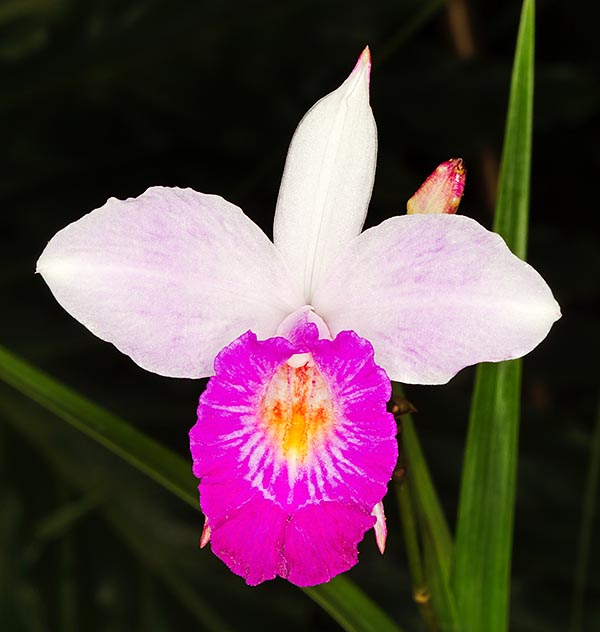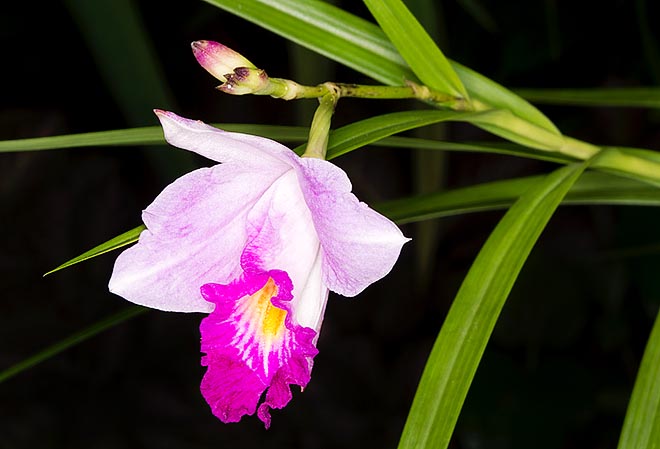Family : Orchidaceae

Text © Pietro Puccio

English translation by Mario Beltramini

Arundina graminifolia is a tropical terrestrial orchid with even 2 m long stems © Giuseppe Mazza
The species is native to Arunachal Pradesh, Assam, Bangladesh, Bhutan, Borneo, Cambodia, China (Anhui, Chongqing, Fujian, Guangdong, Guangxi, Guizhou, Hainan, Henan, Hong Kong, Hubei, Jiangsu, Jiangxi, Kin-Men, Macau, Ma-tsu-Pai-chúan, Shanghai, Sichuan, Tibet, Yunnan and Zhejiang), Darjeeling, India, Java, Laos, Lesser Sunda Islands, Maluku, Myanmar, Nepal, New Guinea, Peninsular Malaysia, Philippines, Sikkim, Singapore, Sri Lanka, Sulawesi, Sumatra, Thailand and Vietnam, where it grows in the thickets and forests, in open and sunny spaces and along the banks of the rivers up to about 2800 m of altitude.
The name of the genus comes from the Latin “arundo” = cane, with reference to the thin stems; the name of the genus is the combination of the Latin terms “gramen” = stem, blade of grass and “folium” = leaf, with reference to the thin leaves similar to grass blades.
Common names: bamboo orchid, grass orchid (English).
The Arundina graminifolia (D.Don) Hochr. (1910) is an evergreen terrestrial herbaceous species with 0,4-2 m long erect stems of about 1,5 cm of diameter, with alternate, distichous, oblong-lanceolate leaves with pointed apex, 10-25 cm long and 1-2 cm broad, with the base embracing the stem, of pale green colour.
Erect terminal inflorescences, simple or ramified, 5-25 cm long, carrying up to 10 flowers of 6-7 cm of diameter, perfumed and short-lasting, which open in succession, with coriaceous floral bracts, about 0,5 cm long, elliptic-lanceolate sepals with pointed apex, 2,5-4 cm long and 0,8-1 cm broad, white to pink coloured, more or less intense, at times shaded of purple, obovate petals, up to 4 cm long and 2 cm broad, of the same colour of the sepals, tri-lobed labellum up to 4 cm long and 3,5 cm broad, with lateral lobes folded on the column and central lobe with retuse apex (rounded apex with a slight indentation), ruffled margin and three lamellae at the base, of more or less purple colour, and clavate column 1,5-2,5cm long; there is a rare variety wholly white with a small yellow spot on the labellum. The fruits are 3-3,5 cm long capsules of 0,8-1,5 cm of diameter.

The leaves seem grass blades and the inflorescences have several ephemeral perfumed 6-7 cm flowers © G. Mazza
It reproduces by micro-propagation and, at amateur level, by division, with each section provided of at least 3-5 stems, and through the young plants which generate at the base of the inflorescence and along the stems, that can be made rooting in sand or gravel. In ideal conditions, it expands so quickly to become, in some instances, invasive.
Vigorous species of easy cultivation and adaptability, seen the wide origin area, very popular in the past in the tropical and subtropical gardens, it loves the full sun and draining soils rich of organic substance with regular waterings, but avoiding stagnations, and organic fertilizations.
The humidity must be high, around the 70%, in dry air situations are useful the nebulisations utilizing rain water, or water obtained by reverse osmosis or demineralised; the night lowest temperatures should not be under the 10 °C, even if it can stand exceptional and very short-lasting values around the 0 °C. Where the climate does not allow the continuous permanence in open air, it can be cultivated in a large enough pot, in an as much as possible luminous position, with a good drainage realized with fragments of earthenware and organic loam with addition of siliceous sand.
The species is inserted in the appendix II of the CITES (species whose trade is internationally ruled).
Synonyms: Ophrys arundinacea Noronha (1790); Arundina chinensis Blume (1825); Arundina speciosa Blume (1825); Bletia graminifolia D.Don (1825); Arundina bambusifolia Lindl. (1831); Arundina minor Lindl. (1831); Cymbidium bambusifolium Roxb. (1832); Arundina densa Lindl. (1842); Cymbidium meyenii Schauer (1843); Arundina affinis Griff. (1851); Arundina meyenii (Schauer) Rchb.f. (1852); Arundina philippii Rchb.f. (1852); Arundina pulchella Teijsm. & Binn. (1855); Cymbidium speciosum Reinw. ex Lindl. (1859); Arundina pulchra Miq. (1861); Arundina densiflora Hook.f. (1890); Arundina revoluta Hook.f. (1890); Limodorum graminifolium Buch.-Ham. ex Hook.f. (1890); Arundina sanderiana Kraenzl. (1893); Arundina stenopetala Gagnep. (1932); Arundina maculata J.J.Sm. (1933).
→ For general notions about ORCHIDACEAE please click here.
